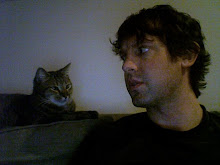It's a book with 40 pages and 10 sentences. Maurice Sendak wrote it in the 60's to a heavily mixed reception until it eventually became an established classic and a hallmark of childrens literature. Given the brevity of the material and the state of basically all film adaptations of storybook classics it's amazing that a workable 90 minute movie could be lifted from "Where the Wild Things Are." Lucky for us, Maurice Sendak isn't your normal kids author and Spike Jonze isn't your normal film director.
Aside from the animated version from the 70's (which clocked in at a staggering seven minutes) a full length feature seemed not only a generally bad idea, but seemingly implausible without the contrivances of "back story" and inflated, heavy handed thematics (Ron Howard's The Grinch comes to mind...) Then in steps independent visionary director, Spike Jonze (Being John Malkovich and Adaptation,) having struck up a genuine friendship with Maurice, took the project in an unexpected and daring direction. With Sendak's blessing to "do whatever you want with it," Jonze teamed up with author Dave Eggers (A Heartbreaking Work of Staggering Genius and this year's indie hit Away We Go) to bring out the thematic importance of not only what the book is about, but what it truly means to those that have enjoyed it for generations.
As the story goes, Max, adorned in his wolf costume, is an unruly child that is sent to bed without any supper after causing more mischief than his mother is willing to deal with. Max creates a fantasy world in his bedroom and sails to the land of the "Wild Things" and becomes their king. All the elements of the book are prominently featured (even down the the opening, pre-credits sequence in which a rambunctious Max chases his pet dog with a fork.) The expansions on the material consist of exploring the reasoning for Max's behavior. What causes him to act out? Why does he feel the need to escape? What ARE the Wild Things, realistically and to Max? The film meets Max as a normal kid with an overactive imagination. His parents are divorced and his sister is too old to be his friend any more. This is a child dealing with feelings and emotions he doesn't even understand yet, let alone knows how to deal with on any real level. Therein, whether his trip to the land of the Wild Things is real or not, it's an internalization and a personal mirror for Max to work through his feelings.
Each of the Wild Things represents a piece of Max and at the same time, pieces of the opening 1o minutes are either revisited or presented in a new light during Max's visit. The lead creature, Carol (voiced amazingly by Tony Soprano himself, James Gandolfini) is the closest representation of Max, and ultimately becomes his best friend. Ira (Forrest Whitaker) plays to Max's creative side and his island partner, Judith (Catherine O'Hara) sometimes represents Max's feelings on his older sister. KW (Six Feet Under's Lauren Ambrose) is the closest creature to representing the mother figure and the catalyst for many of the emotional squabbles. There are no heavy handed morals, or extensive speeches that come out and say all the lessons presented in the contained material, these are left for interpretation by the viewer.
Max Records, the breakout star as the aptly named Max, puts on the most genuine and honest performance of any child character ever seen on film. When I say Max is a genuine little kid, he IS a REAL little kid. He's not the wise-beyond-his-years, prodigal child that speaks like an adult that we see in every other kids movie. He thinks and speaks like a REAL little kid. He moves like a REAL little kid. His logic is mired in the trappings of a REAL kid's imagination and that's why it works so well. While some of the more intricate ideals in Where the Wild Things Are may not be apparent to some children, they should be able to at least relate to Max on a fairly personal level (given they've got the capacity for at least some imagination.) Catherine Keener makes a brief but notable appearance as Max's tired and exasperated mother. She does a wonderful job of evoking sympathy while standing in the way of Max's journey.
Where the Wild Things Are sets the bar pretty high for a family film. It doesn't talk down to the audience, but operates on the fact that while you may not know what you're feeling during or afterward, you genuinely felt something. It's there to let us know, it's ok to feel scared and sad sometimes, even if we don't know why or how to fix it. These are the things that make us human and these are the things we need to come to understand when it comes to growing up. And growing up is ok, but it's also ok to keep that inner child on standby because you should never have to take everything so seriously.





